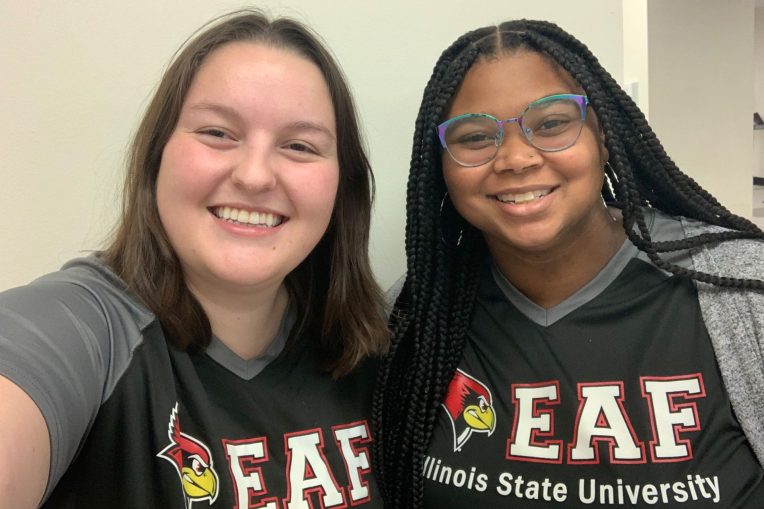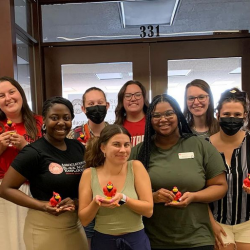Leiana Boldon’s browser history was littered with visits to the National Association of Student Personnel Administrators (NASPA) website this past July. The Illinois State graduate student was laser-focused on nabbing one of NASPA’s 50 slots for the graduate associate program (GAP), and the application portal was slated to open at any time.
Her diligence would pay off, and her materials were among the first to hit the organization’s database.
“I’m just the type of person who, whenever I hear about an organization that I want to be a part of, I research everything about it. So, I was definitely stalking their website,” said Boldon, a second-year student in the College Student Personnel Administration (CSPA) master’s program.
She got the news of her selection as a GAP intern in September, along with Maddy Botts, another member of her CSPA cohort.
What’s it worth?
To an outsider, the opportunity might not seem glamorous at first glance. The GAP role is unpaid and remote, and they’ll serve the organization on top of already busy schedules as second-year students.
However, NASPA is a preeminent organization in the field of student affairs in the U.S. The associate role is a chance to be a part of an extensive community of higher education professionals around the country. To fulfill the GAP requirements, they’ll host events at least three events to inform and educate undergrads, their fellow CSPA students, and those new to the field about NASPA’s resources and career opportunities in student affairs.
They’ll also collaborate regularly with their other GAP participants from across the country.
“It’s kind of fun to be outside of the Central Illinois bubble while still being at ISU. GAP is a remote opportunity, but it’s a national opportunity,” Botts said.
Over the last two months, Boldon has already rubbed some shoulders (virtually) with NASPA’s leadership team. In October, she moderated their coffee break webinar where the high-ranking members shared how they support colleges, universities, and personnel across the country.
“It was a great opportunity to get some face time with the administration of this huge organization,” she said.
Meanwhile, Botts volunteered to do an Instagram takeover of the GAP’s account, sharing a day in the life of a Redbird graduate student with the NASPA audience.
“It was a great opportunity not only to share about my life here at ISU but also about the opportunities that the program provides. I feel it would have been helpful when I was looking for a master’s program to see something like a ‘day in the life’ to give me a feel of the program and what it truly means to be a grad student. Plus, I got to interact with questions and NASPA followers all over the place and get my name out there.”
Hearing about the GAP?
When Botts reached out, their professor and CSPA’s coordinator, Dr. Gavin Weiser, was quick to write a letter of recommendation to facilitate Botts and Boldon’s GAP applications.
“Dr. Weiser was so happy we were pursuing the opportunity, and we got a lot of encouragement from [assistant coordinator] Dr. Marci Rockey, too,” Botts said. “Their response was really motivating.”
NASPA’s GAP program was on the Redbirds’ radar after attending the organization’s regional and national conferences last year. The Department of Educational Administration and Foundations, which houses the CSPA program, funded the entire cohort’s conference fees and travel. It’s one of the ways the unit invests in and encourages EAF students to become future leaders.
“The conference was an incredible opportunity to be surrounded by people who wanted to push the field forward, people who are full of ideas and programs,” Botts said. “It was an experience that combined networking, professional development, and inspiration.”
GAP participants will also attend the 2024 national and regional conferences. The 50 interns will also compete for eight spots to be organizers of the national conference. It’s an opportunity to rub shoulders with NASPA representatives and presenters at the next meeting, hosted in Seattle.
“I’m excited about that potential opportunity. It’s a chance to be involved behind the scenes, to see how the conference is run, and to connect with NASPA and student affairs leaders as a GAP intern, which is definitely going to be different,” Boldon said.
The CSPA difference
As a graduate of Bradley University in Peoria, Boldon’s roots are in Central Illinois. However, Botts is a Virginia native and a James Madison University alum. Her process for choosing Illinois State mirrors Botts’ thoughtful approach to GAP. After a bevy of research on student affairs graduate programs across the U.S., the intricacies of the University’s CSPA program had her college compass pointing to Normal.
“I really wanted to get a lot of professional practice while earning my degree, and Illinois State’s program stood in terms of offering those experiences,” she said. “Talking with GAP interns from other states, I had it right. None of them get as much on-the-job experience as we do.”
Full-time CSPA students spend most of the summer between their first and second years in a practicum experience with most students choosing to go out-of-state to explore a new context. They also participate in a semester-long fall practicum with a college or University in Central Illinois, usually during the fall of their final year in the program.
This semester, they each are completing their practicum at Illinois Wesleyan, a private university in Bloomington, located just a few miles away from Illinois State’s Normal campus. Botts serves the Office of Student Involvement while her fellow Redbird is working in the Office of Diversity.
Boldon’s latest project is a survey assessment connecting her coursework, the GAP role, and her work at Wesleyan. The goal is to determine how students feel about Wesleyan’s Office of Diversity. She’ll be sharing the experience with NASPA, so they can address similar questions for the organization’s initiatives and activities.
“I am using what we’ve learned about assessment design in the CSPA program to see how students feel about what the diversity office is doing, and whether or not they are actually feeling included, welcomed, and accepted, or not,” she said.
“The common theme, for me, is that we should probably figure out what students want before we implement ideas. We’re here for the students in the first place, so let’s hear from them.”
Her efforts reflect an effort colleges and universities are undertaking to inspire and create a sense of belonging among all students, and most of that work takes place outside the classroom. About 70 percent of a student’s time on a college campus is spent on non-academic experiences.
Meanwhile, Botts is interested in cultivating leadership capacity among students outside the classroom. She is currently running Wesleyan’s Do-Good Leadership Series, and it’s helping her to find her career trajectory.
“This work has inspired my desire to work with student leaders,” she said. “I’ve just found that that’s my passion. Whether that’s in housing, student involvement, or the vice president’s office, I would like to follow a path that allows me to continue this work.”
The GAP experience is just one piece of Botts and Boldon’s college experience, but they’ve proven something to themselves and their future employer. Their eyes are wide open, and their research is sound.


